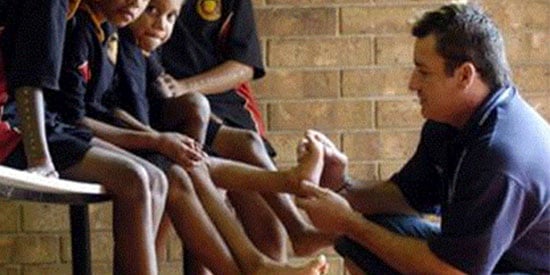Step forward for culturally-inclusive foot health
Research news
A Deakin University researcher has undertaken world-leading research to understand and combat the prevalence of poor foot health in Aboriginal and Torres Strait Islander peoples.
For Aboriginal and Torres Strait Islander peoples, poor foot health is commonly thought to be solely a result of diabetes and/or smoking. But Associate Professor James Charles has gone one step further to investigate the evolutionary prevalence of equinus – limited range of motion (bending the ankle joint upward toward the body) – in Aboriginal and Torres Strait Islander peoples.
Evidence demonstrates Aboriginal and Torres Strait Islander people have a three to six-fold increased risk of diabetes related foot complications including neuropathy, foot ulcers and lower limb amputation compared to non-Indigenous people.
A/Prof Charles is a proud Kaurna man from the Adelaide Plains in South Australia who coordinates the Master of Public Health at Deakin University’s National Indigenous Knowledges Education Research and Innovation (NIKERI) Institute. His ethos centres on working with and for Aboriginal and Torres Strait Islander people to improve their health.
“Research should really be and is community-owned. At the end of the day, the research I do is part of the Aboriginal and Torres Strait Islander people who it is being collected from. While trying to get some kind of improvement, there really has to be community ownership and collaboration, otherwise it’s not going to work,” A/Prof Charles said.
“It’s research for and with Aboriginal and Torres Strait Islander peoples.”
Through meeting with community, A/Prof Charles examined how the foot biomechanics of Aboriginal and Torres Strait Islander people differs from non-Aboriginal people, and therefore creates more issues as they age. This work is critical in understanding who is at risk to ensure they are treated early on and regularly.
Using clinical assessment, he has created a device, the Dorsi-Meter, to identify and measure equinus in individuals. In a recent study, he found that about 90 per cent of Aboriginal and Torres Strait Islander men and 50 per cent of Aboriginal and Torres Strait Islander women had this limited range of ankle joint motion. The condition is associated with athleticism, and continues to be of advantage for the athletic ability of Aboriginal and Torres Strait Islander people.
A/Prof Charles’ research has paved the way for the next step towards preventing forefoot pressure and consequential health issues for people with equinus feet. Not only ‘set-and-forget’ treatments like shoe inserts or stretches are needed, but regular, ongoing treatment – especially for Aboriginal and Torres Strait Islander people who are more at risk.
Beyond the numbers, this work must be a collaborative, empathetic process.
“No matter how quantitative the data is, you can always give a voice to the Aboriginal or Torres Strait Islander participant, to ask ‘How do you feel about this and how is your foot health affecting you?’,” A/Prof Charles said.
As part of his research, A/Prof Charles assessed ancient footprints, estimated to be over 21,000 years old, at Lake Mungo. The footprints were 3D-scanned and made into casts to compare with Aboriginal and Torres Strait Islander people’s feet today.
“I’m really grateful and honoured to have had the opportunity to go to Lake Mungo,” he said. “We found – in terms of range of motion in the foot and arch height – the results were almost the same as the data we’re looking at today.”
Since completing his PhD in 2016, A/Prof Charles has worked tirelessly to show the value of foot health and podiatry services for Aboriginal and Torres Strait Islander peoples. Now, he is eager to see the clinical translation of his work. He is currently working towards preparing podiatry practice guidelines for Aboriginal and Torres Strait Islander foot health.
“I would like to see ankle joint range-of-motion testing as part of any new patient assessment for any Aboriginal or Torres Strait Islander person that comes to a clinic – especially any person that is pre-diabetic or has diabetes – to identify those at risk and measure their range of motion over time,” he said.
“It’s really about seeing at-risk people on a regular basis; having better funded, local, culturally-inclusive medical services, and training more Aboriginal or Torres Strait Islander podiatrists or foot health practitioners. I think that is all part of the solution.”
For more information:
- National Indigenous Knowledges Education Research and Innovation (NIKERI) Institute
- Recent research papers, here
Share this story

Key Fact
Associate Professor James Charles working with young people on Kaurna country.
